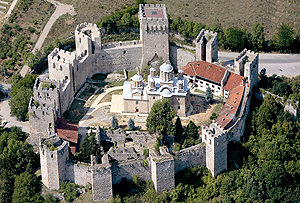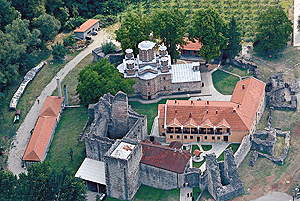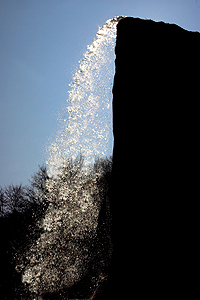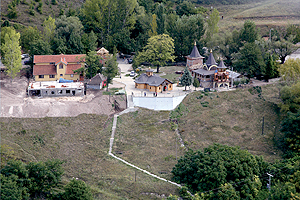Serbia from Above
RESAVA, THE LAND OF NATURAL AND SACRAL GIFTS
Measured from the Sky
This area is an important center of Serbian religious life, one of the outlines of medieval Moravian Serbia, which was also a principality and a despotate. Manasija, Ravanica, Sisojevac, but many other churches and monasteries from the 14th and the 15th century are standing here as golden knots of a rosary. They preserve sacred relics, well-known icons and frescoes, centuries and roads above time. This spiritual and cultural heritage, as well as outstanding natural beauties and rarities of the area are the reason for which ”National Review” is beginning its series called ”Serbia from Above” right in this place
Text by: Nevena Mihajlović and National Review Press
Photos by: Dragan Bosnić
 We flew with the members of the aero-club from Paraćin, in the golden days which were pretty rare this autumn. The beginning of the flight was marked by the blue cupolas of Manasija, the pearl of sacral architecture from the most prosperous time of the Despotate. We flew with the members of the aero-club from Paraćin, in the golden days which were pretty rare this autumn. The beginning of the flight was marked by the blue cupolas of Manasija, the pearl of sacral architecture from the most prosperous time of the Despotate.
Manasija is placed 130 kilometers away from Belgrade, near the former village Vojnik. It was built of cut stone. The gate and the mosaic of the Holy Trinity (to which the church is dedicated), above the entrance, were built some time later. As the time passed, this entire area was identified with the founder of the monastery, Despot Stefan Lazarević. That is why village Vojnik changed its name into Despotovac. The central square also has the Despot's name and a monument dedicated to him is standing on it. Every year, on the Day of the Transfiguration of Christ, there are religious ceremonies dedicated to this Serbian ruler and writer.
With its slim figure and its height, Manasija is dominating the entire area. It is surrounded by high ramparts with eleven towers. One of them is Despot's or Donjon Tower, with an opening below it. At first, it was said that there was a well down there, but further investigation showed that it was a granary in which one could put grain for the whole year.
Through the past and the present of this monastery, we were led by the painter and icon painter Momčilo Vukasović, a great connoisseur of the area.
King Aleksandar Karađorđević gave this bell as a gift to the monastery. That bell and the other bells of Manasija were heard all the way to Svilajnac. After World War II, the new government ordered to close the western part of the tower, so that nobody can hear the bells. But even the built in bells were heard far enough and long enough to even reach the present times – says Vukasović.
 Both from the sky and from the ground, we can see the ruins of the former working room in which worked the famous School of Resava. Many centuries have passed but many works have been saved since the present times. Among them, there are valuable writing of Constantine the Philosopher, a biographer and the contemporary of Despot Stefan. Given that the archaeological research is still taking place, we cannot enter the old working room. Both from the sky and from the ground, we can see the ruins of the former working room in which worked the famous School of Resava. Many centuries have passed but many works have been saved since the present times. Among them, there are valuable writing of Constantine the Philosopher, a biographer and the contemporary of Despot Stefan. Given that the archaeological research is still taking place, we cannot enter the old working room.
We know that there was a secret passage from the Resava River to the castle. There are many more exciting secrets of Manasija, and they will remain secrets to be told and solved, in pursuit and presentiment.
The library of the monastery preserves a Gospel which the Russian Empress Katarina gave as a gift to Manasija. The covers of the Gospel are made of pure platinum – says Vukasović. – During World War I, a soldier of the name Stojanović carried a Gospel instead of a rifle, and his only task was to bring it back undamaged to the monastery. He succeeded even though he made it all the way to Corfu with his fellow soldiers.
It is said that the Turks have robbed Manasija and brought seven cargos of gold with them. The present gaps on the frescos and icons have been filled with that very gold, a long time ago. But the original Byzantium blue color is preserved which cost two times more than the gold. The cupolas of the church of Manasija also remind us of the Byzantium blue, as we finish our flight above the sacred place and we continue...
THE EVERLASTING RESTORATION
 Before the beginning of our flight, Bratislav Trifunović (Ph.D.), the president of Despotovac community said: Before the beginning of our flight, Bratislav Trifunović (Ph.D.), the president of Despotovac community said:
We have two main goals. The first is to pay respect to Manasija and the holy Despot, an outstanding figure of Serbian and European history. The other goal is the represent the municipality of Despotovac, to shows its tourist potentials, natural resources, an area which is extremely suitable for serious investment. The infrastructure is above all, the condition for all other conditions. For the beginning of next year we are planning the reconstruction of the road Despotovac-Svilajnac, but also the building of lodging capacities which are necessary. We also have a master plan made for Beljanica, Južni Kučaj and Stig with which we can have a long-term project of the territory of Despotovac municipality. Our big problem is that young people are leaving the area. We believe that this kind of development of Despotovac would at least lessen this problem.
On our way from Despotovac to the monastery, on the bank of Resava, which is preserved as a natural reservation through all its flow, lies Despotovačka Spa, with the water temperature of 36˚C, which is lowered to 26˚C, after incautious construction works on a nearby hill.
 The edge of Divljakovačko field is hollowed out with Resavska cave, Ravanička cave and smaller ones. From the slopes of Kučaj mountains on the way to Velika Morava River there are several rivers and smaller rivers, and on Resava River there are several beautiful waterfalls. A big waterfall, near Resavska cave, on the locality called Lisine, is more than 20 meters high! We can also see the slopes of Beljanica and one can easily reach its top following a marked path. The edge of Divljakovačko field is hollowed out with Resavska cave, Ravanička cave and smaller ones. From the slopes of Kučaj mountains on the way to Velika Morava River there are several rivers and smaller rivers, and on Resava River there are several beautiful waterfalls. A big waterfall, near Resavska cave, on the locality called Lisine, is more than 20 meters high! We can also see the slopes of Beljanica and one can easily reach its top following a marked path.
On the tributary called Resavica there is a waterfall Prskalo, already familiar to readers of ”Princip Press” editions (Serbia – by Roads, Railways and Rivers). We are now taking pictures of it from a totally unusual angle. Under the hill from which the water of Prskalo is dispersing there are pools on polished rocks with grass grew over them. We see a trunk over the water and we remember one winter which gave us a lot of trouble, in the snow and on a very slippery road.
We already said that this area is marked by natural beauties and sacred places. So, we are continuing our flight to Ravanica Monastery, the endowment of Despot’s father, Prince Lazar Hrebeljanović, the hero of Kosovo and the martyr, the hero whose choice and suffering marked the central Serbian religious vertical thorugh all times.
Ravanica stands beside the road which leads from Paraćin and Ćiprija to senje and the mines. Its cupolas are also in Byzantium blue, from above. It was also surrounded by strong ramparts, from which we only have the remains today. The church is dedicated to the Ascention of Jesus Christ. Inside it, we can find the holy relics of Prince Lazar, which were brought back in the end of 1980’s after many centuries.
The beautiful church was several times devastated and destroyed. The restoration which was started by Karađorđe and continued by Miloš Obrenović is still going on. Last summer, underfloor heating was set in the church, and the 19th century palaces are placed instead of former ramparts.
CRNICA RIVER WITHOUT THE COLOR BLACK
 A little bit further flows the River Crnica. On the way to Velika Morava River, it carries all the colors of the world in it, except black. That is why the origin of its name should be found in historical texts, especially in those from the Turkish occupation. Uniting three streams near the village of Sisevac, this river goes through the rocks for 17 kilometers. On the place where it disappears we see the remains of three monasteries. Near them is the Monastery Sisojevac, which was built by Saint Sisoje, the priest of Prince Lazar. From above (which is now the church property of Ravanica), it seems that the past and the present beauty of this monastery is even more expressed. We are not approaching it, but we know that three layers of painting are on the church walls. The most valuable one was painted by the masters of Ravanica. The eager nuns of the monastery have brought back the life into it. A little bit further flows the River Crnica. On the way to Velika Morava River, it carries all the colors of the world in it, except black. That is why the origin of its name should be found in historical texts, especially in those from the Turkish occupation. Uniting three streams near the village of Sisevac, this river goes through the rocks for 17 kilometers. On the place where it disappears we see the remains of three monasteries. Near them is the Monastery Sisojevac, which was built by Saint Sisoje, the priest of Prince Lazar. From above (which is now the church property of Ravanica), it seems that the past and the present beauty of this monastery is even more expressed. We are not approaching it, but we know that three layers of painting are on the church walls. The most valuable one was painted by the masters of Ravanica. The eager nuns of the monastery have brought back the life into it.
Crnica River flows through the slopes of Kučaj, where we find another monastery property: the ruins of Namasija Monastery, with the remains of the Church of St. Nicholas the Miracle Maker. The only thing left is the parvis, and thirty years ago it was turned into a chapel. When the basis were dug up there were relics found which can now be seen in the Museum of Paraćin.
Further down the river is Perin jaz (abyss) on which stands a small waterfall and the road leading to the wider part of the river near the village Zabrega. Some time ago this area was called Sokolar. The falcons were exterminated by hunters, and the name was forgotten in time. In World War II, the Germans attacked the nearby village Šaludovac and when they got up the hill, the turned around. The thing that they did not know about which was behind Zabrežje hill saved lives of many people. On that road, down the river, we have five water mills which still work. The most important thing is that there is enough water but grist as well.
While our airplane is flying in the clear sky, shining in the sun, one part of the crew is meeting a local resident Miroslav Đurić, employed in the nearby cement factory ”Holcim” in Popovac. He told us many things about the history of the area, about plans considering country tourism, about the restoration of churches and monasteries... When the right time comes. If every each of us does us much as he can, this will be realized. But, as long as we have these plans, there is also hope and optimistic views.
Down the canyon, about one kilometer away from the last village houses, there are remains of the monastery dedicated to St. John. People are gathering here on Beheading of St. John the Baptist, on September 11th when the village slava is taking place as well. Above the monastery complex stood the fortification called Petrus. We can see it clearly from above: the so-called Krstasta stena (Cross-Shaped Rock), a part of the wall and the tower are the only things left from Petrus. People say that the town was inaccessible from three sides. After a long siege the Turks found a way to attack the fourth side, the one near the cliff which was not guarded. What was not destroyed by the Turks it was surely ruined through time and shook up by everyday mining in the quarry of the nearby cement factory.
Besides Popovac, the village with the cement factory, we reach the last of the Resava monasteries: Davidovica. Lešje Monastery is under the Baba Mountain. The church got an usual Russian and Ukrainian style during its renovation.
Finally, when we reach Paraćin following Crnica River, our plane is successfully landing. While Crnica joins with Velika Morava, the ground and the celestial part of our reporting team will joins as well.
The other time we fly like this maybe Paraćin and Ćuprija will become one. Until then, it would be good if we think about what we do and how well-measured it should look from the sky.
***
Stepson and stepmother
Near the entrance gates of Manasija Monastery (Resava) stand the hills Pastorak (stepson) and Maćeha (stepmother). The legend says that on the top of this unique hill stood a woman who turned into an evil stepmother from a good bride, killed a boy, her stepson. After they found out about the crime, the peasants punished her by killing her in that same place. At that moment, the legend says, both bodies were petrified. And there was great injustice, because the criminal and the innocent victim were left united forever in death. That is why they say that Resava cut through the mountain right through the middle in order to tear them apart.
***
Devojačka Rock
Near Namasija stands Devojačka (Girl's) Rock, called after a girl who died while running away from a Turkish man. The legend says that the girl waited for the man to approach her, then she grabbed him and threw both of them into an abyss.
***
Marko’s heart
Near Namasija Monastery stands Badnji whirlpool, in which young men bath on Christmas. Above the whirlpool is Marko's Rock and another legend attached to it. One shepherd wanted to come to blows with a bear which caused him troubles. But, in the most important moment, when he waved his axe from ambush, the blade was stuck between two rocks. The bear approached, stretched out its paw and torn up his shirt with its claws. The bear did not hurt him, but only turned around and walked away. Marko returned to his cabin, uninjured but his heart stopped. He died of great fear.
|
